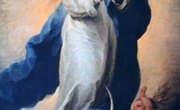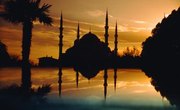The Middle Ages stretched from the fall of the Western Roman Empire in the late fifth century to the beginning of the Renaissance in the 15th century. During that millennial period, the Roman Catholic Church dominated the European world, and its influence on all aspects of culture and day-to-day life was absolute. The West, including the New World yet to be mapped and exploited, was irrevocably shaped by the conventions and inventions of the medieval Catholic Church.
Spiritual Supremacy
The fragmented sects of early Christianity coalesced under the leadership of Rome and the pope by the early Middle Ages. The Roman Catholic Church was the only official religion and dictated spiritual practices across Europe as it amassed great power and wealth. One notable development during this time was the rise of monasteries. Monastic life offered the chance to withdraw from the chaotic world and devote days and nights to prayer and manual labor or scholastic work. Monks and nuns were believed to be earning merit for the rest of the faithful with their own piety and sacrifices. The abbots of large monasteries counseled kings and emperors, collected compulsory tithes that reinforced the feudal system of serfs and tenant farmers, and oversaw a mission to provide shelter for travelers, educate the privileged, tend the sick, solicit alms for the poor and build religious communities that survive until today.
Literacy and Illumination
Catholic monasteries played a major role in preserving and disseminating scriptures and classic literature, scientific and philosophical treatises and historical accounts. In the scriptorums of monasteries, monks dedicated their lives to copying manuscripts by hand, translating from Greek to Latin and illustrating pages with elaborately embellished letters and depictions of biblical events, mythical animals and religious icons. In many cases, monastic libraries saved important ancient texts for posterity. Bibles and prayer books were copied for local ministries, academic work was used in monastery schools and universities, and maps and histories were collected and preserved. Many records of past civilizations were preserved by the monks, and that knowledge was shared with those they taught.
Art and Architecture
Although the monastic life was designed to be austere, asceticism in no way characterized the art inspired and commissioned by wealthy abbots and leaders of the Church as well as members of the Catholic aristocracy. Rich patrons financed artists who created enameled objects and mosaics, engraved gold reliquaries and chalices, stained glass windows, paintings with a religious theme, embroidered tapestries, and sculptures in marble, metal and wood.
The buildings that housed these treasures were marvels themselves. Churches were built in the Romanesque style and, eventually, in the airier Gothic style with distinctive arches, graceful flying buttresses, metal supports and ribbed vaults. Structural innovations meant that cathedrals reached for the heavens, towering over the surrounding countryside. Acoustics in churches were refined. Church architecture was adapted to castles positioned to intimidate adversaries and defend political domains. The world has Giotto's masterpieces and Chartres Cathedral today because of the medieval Roman Catholic Church.
Divine Music
Liturgical music, in the form of instrumental and vocal compositions, were available to most of Europe's burgeoning populations in cities and rural provinces. Monastery chapels rang with the haunting refrains of plainchant as monks chanted the Divine Office, a cappella, from predawn to evening. To share their compositions among monasteries, monks developed the first musical notation, so they were able to write down notes and directions for loud, soft, rapid and slow performance. Monastic musicians used a staff, clefs, lines and spaces and allowed for harmony and polyphony. German abbess Hildegard von Bingen and French monk Moniot d'Arras were medieval religious composers whose work is still extant.
Related Articles
References
- The Metropolitan Museum of Art: Monasticism in Western Medieval Europe
- History.com: The Middle Ages
- PBS Nova: Building the Great Cathedrals
- Medieval Life; Andrew Langley; 2000
- The Metropolitan Museum of Art: Medieval Art -- A Resource for Educators
- The Oxford Companion to Music; Alison Latham, ed.; 2002;
Writer Bio
Benna Crawford has been a journalist and New York-based writer since 1997. Her work has appeared in USA Today, the San Francisco Chronicle, The New York Times, and in professional journals and trade publications. Crawford has a degree in theater, is a certified Prana Yoga instructor, and writes about fitness, performing and decorative arts, culture, sports, business and education .











